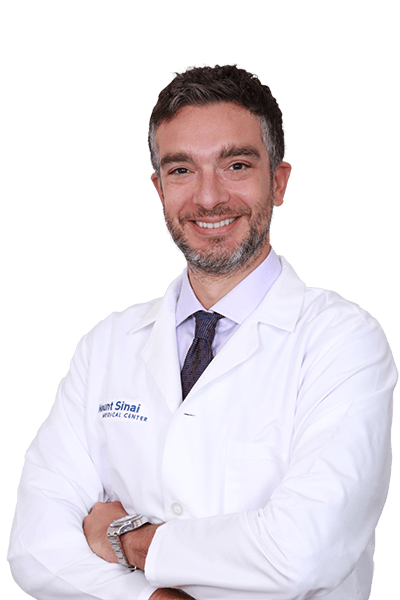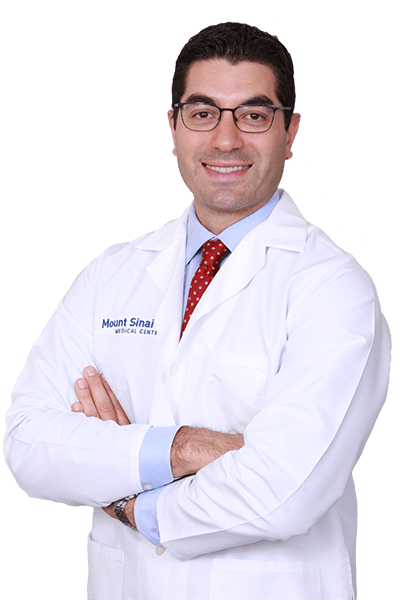Foot & Ankle
Our surgeons have pioneered minimally invasive foot and ankle surgery in North America to address a vast array of conditions. Minimally invasive surgery can be used to treat ankle arthritis, foot arthritis, Achilles tendinitis, bunions, hammertoes, Charcot foot, fractures, and more. Further, thanks to the use of 3D printing technology, the most modern total ankle replacement surgery can be performed as an outpatient procedure with early postoperative weight bearing.
Injury, Trauma, & Overuse Conditions
Traumatic injuries from accidents and sports, as well as injuries related to overuse of a particular body part, can lead to damage to feet and ankles. Those injuries can be treated by the Mount Sinai orthopedic team, which is part of the Columbia University Division of Orthopedics.
For orthopedic injuries of the feet or ankles, our team uses advanced diagnostic tools, including powerful MRI, to see microscopic tears in tendons (which connect muscles to bone) and damage to ligaments (which connect bones to bones), as well as tiny fractures to bones. These diagnostic imaging tools allow the Mount Sinai team to choose the most appropriate treatment approach, which may include:
- Hard casts to immobilize the injured bones
- Slings or braces to minimize movement and strain
- Physical therapy
- Injections of steroids and other medicines to promote healing and reduce pain
- Minimally invasive arthroscopic surgery
- Surgery utilizing metal plates and screws
- Tendon transfers and reconstruction
The physicians, technologists, and other providers on the Mount Sinai orthopedic team use these treatments in addition to other approaches, for nearly every type of foot and ankle injury, including the following:
Achilles Tendon Rupture
The Achilles tendon is a long, thick tendon that connects your calf muscle to your foot. You can easily see and feel the Achilles tendon at the back of your ankle. It’s not uncommon for the Achilles tendon to tear from a sports injury, but it can happen from all sorts of accidents. At Mount Sinai, our team of orthopedic specialists treats Achilles tendon ruptures with both surgical (minimally invasive, in most cases) and non-surgical methods. In deciding how to treat the injury, we consider the patient’s age and activity level, as well as if they have any other conditions that might affect how they handle surgery and heal.Foot and Ankle Fractures
A broken ankle bone, foot bone, or toe bone does not always require surgery. Depending on the pattern of the break, certain fractures can be treated with a cast to keep the bones from moving and to allow them to heal. And toe fractures often don’t require any cast or splint. Stress fractures are different from breaks that come from trauma. They often happen to patients with weak bones or people who subject their bones to stress over and over again. For any fracture, if surgery is needed, Mount Sinai’s orthopedic specialists can use minimally invasive approaches that reduce complications and postoperative pain. In fact, most patients can walk shortly after surgery.Foot and Ankle Sprains
We frequently hear the term “sprain,” and use it to describe mild injuries; however, sprains have a specific meaning. They refer to an overstretched or torn ligament, which is the tough band of tissue that connects bones together. Most sprains can be treated by temporarily immobilizing the foot, ankle, or toe, sometimes with a brace, but often just by staying off your feet. Icing a sprain can also help reduce swelling. As the sprain begins to heal, we often recommend physical therapy to ensure a full recovery.Turf Toe
This traumatic injury occurs when the big toe is abruptly stretched up and the ligament that connects the bones in the toe gets torn. It is mostly seen in football players. Because turf toe can cause instability, we may use a minimally invasive surgical approach to repair the torn ligament.Arthritis
Arthritis is a general term used to describe joint pain or joint damage. It can be caused by a wide range of conditions, including degeneration that increases with age, inflammation – sometimes from an auto-immune disease like rheumatoid arthritis – or various types of infection.
The team at the Columbia University Division of Orthopedics at Mount Sinai Medical Center treats nearly all forms of arthritis, including those that affect feet and ankles. Our specialists treat arthritis depending upon which joint or joints are affected. Many kinds of arthritis can be effectively controlled with anti-inflammatory medications, such as a non-steroidal anti-inflammatory like ibuprofen. Topical anti-inflammatory medications can also help. Our physicians also use steroid injections and physical therapy. Even the use of different shoes and custom insoles can help alleviate pain.
For more severe cases, joint replacement surgery can eliminate pain and help a patient gain their lost range of motion. Mount Sinai’s orthopedic surgeons also use advanced surgeries like tendon grafts to reconstruct certain joints. Our interventions treat the follow forms of arthritis that affect feet and ankles:
- Ankle arthritis
- Foot arthritis
- Hallux rigidus (stiff big toe)
Orthopedic Defects & Deformities
Some patients are born with certain deformities. These cases are known as congenital, which means “from birth.” Other deformities can occur later in life as the result of injuries, disease, or overuse. They can also occur spontaneously without any easily identifiable cause. Mount Sinai’s team of orthopedic specialists provides treatments to address a variety of defects and deformities, including:
Bunionette
Also known as a tailor’s bunion, a bunionette is a bump on the outside part of the pinky toe. Like bunions on the big toe, Mount Sinai’s orthopedic surgeons perform a minimally invasive procedure to take care of the deformity.Clubfoot
Clubfoot can look different on different patients, but in general with this congenital deformity, a baby’s foot is not aligned properly with his or her leg and ankle. It’s caused by tendons that are not long enough. If someone has not had corrective surgery as a baby, our surgeons can repair the deformity, even among teenagers and adults.Flat Foot
Normal feet have a slight arch between the heel and ball of the foot; however, patients with flat feet have a less noticeable arch. Usually, flat feet don’t cause any problems; however, for some people, flat feet can create pain. For these patients we first use physical therapy and special insoles called orthotics. If these don’t help, Mount Sinai’s team of orthopedic surgeons can correct the deformity with sophisticated surgery, including minimally invasive techniques.Haglund’s
Also known as “bump pump,” Haglund’s is an overgrowth of the heel bone that rubs against the Achilles tendon and causes pain. At Mount Sinai, we perform a minimally invasive procedure that only requires a two-millimeter incision to eliminate the bump.Hallux Valgus (bunions)
One of the most common deformities in the foot, bunions are bumps on the inside part of the big toe that can cause pain both at the bump and at the ball of the foot. At Mount Sinai, we use a revolutionary minimally invasive procedure to realign the deformity through tiny incisions. What’s more, patients who undergo this surgery can immediately bear weight on their feet after surgery.Hammer Toe
This deformity occurs when the middle joint of a person’s toe has an abnormal bend that makes the toe aim downward, like a hammer head. Wearing shoes can be painful. Our team of Mount Sinai orthopedic surgeons uses a minimally invasive procedure that requires only tiny incisions to repair a hammer toe.High Arches (pes cavus)
When the arch between your heel and the ball of your foot is higher than normal, it can cause both foot and ankle pain and can lead to inflamed tendons in the heel, ankle, and foot. At Mount Sinai, we use a combination of orthotics, which are special insoles that fit into a patient’s shoe, along with surgery to alleviate the pain associated with high arches.Achilles’ Tendinopathy
Tendons connect muscles to bones, and the largest tendon in the foot and ankle area is the Achilles tendon, which connects your calf muscle to your foot bones. Over time, tendons can wear down or degenerate. At Mount Sinai, our orthopedic specialists treat Achilles’ tendinopathy using several approaches, from physical therapy to minimally invasive surgery.Athlete’s Foot
Most people have athlete’s foot at some time in their lives. It happens when bacteria infects the skin on the foot and in between toes. It’s usually the result of walking barefoot in public spaces. Topical ointments can help cure the disease.Charcot Foot
This severe condition is most common among people with diabetes, but it can occur in people who don’t have diabetes, as well. Charcot foot leads to collapse and crumbling of the foot and sometimes the ankle. In its early stages, we can often treat it effectively by putting on a cast and making sure the patient does not put weight on the foot. However, in later stages, patients can develop pressure sores that don’t heal. These open wounds can sometimes require amputation.Charcot-Marie-Tooth Disease
The most commonly inherited neurological disorder, Charcot-Marie-Tooth Disease causes muscles to weaken, also known as atrophy. This atrophy particularly affects the muscles of the foot and ankle. Patients often develop foot drop, where their foot drags; foot deformities, including very high arches; and hammer toes. Using a combination of minimally invasive procedures, tendon transfers, and realignment procedures, our orthopedic specialists can improve patients’ foot and ankle function along with their quality of life.Diabetic Foot Ulcer
When pressure sores don’t heal, they become open wounds, also known as a diabetic foot ulcer, because they’re most common in people with diabetes. At Mount Sinai we use advanced wound healing approaches, including debridement and pressurized oxygen. We also offer a revolutionary surgical technique called distraction osteoplasty to improve blood flow to the foot, which can increase the healing rate of the ulcer.Foot and Ankle Tendonitis
Tendonitis is the term to describe inflamed or injured tendons, the fibrous cords that connect your muscles to bones. Tendonitis in the foot and ankle area can be caused by many things, including an injury, overuse, inflammation from a disease like rheumatoid arthritis, lupus, or psoriasis. Even certain medications can cause foot and ankle tendonitis. Mount Sinai’s foot and ankle specialists can help patients with all kinds of tendonitis using a range of treatments, from the use of braces and custom shoe insoles, to anti-inflammatory medications like ibuprofen, to physical therapy, and surgery. At Mount Sinai, we treat all forms of tendonitis, including:- Achilles tendonitis
- Ankle tendonitis
- Foot tendonitis
- Peroneal tendonitis
Morton’s Neuroma
Morton’s Neuroma causes enlargement of the nerve between two bones in your forefoot. At Mount Sinai, our fellowship-trained orthopedic foot and ankle surgeons can perform a minimally invasive procedure to open up the space where the enlarged nerve is trapped.Osteochondral Defect
Loss of cartilage, the firm but flexible tissue that cushions bones from grinding against each other, is known as an osteochondral defect. These defects are usually in the ankle and are mostly caused by a sports injury. At Mount Sinai, our fellowship trained foot and ankle specialists can perform arthroscopic surgery to treat the defect by replacing the lost cartilage.Plantar Fasciitis
Plantar fasciitis is the most common cause of foot pain at the bottom part of the heel. It can be caused by either inflammation or degeneration of the ligament that connects the heel bone to the toe bones. Fortunately, most patients at Mount Sinai with plantar fasciitis do not require surgery. Instead, we use a range of treatments, including pain relief medication, physical therapy, custom shoe inserts called orthotics, and steroid injections.Posterior Tibial Tendon Insufficiency
The posterior tibial tendon is the main supporter of the foot’s arch. When this tendon wears down or degenerates, you may experience foot or ankle pain and may also notice the arch of your foot flattens. At Mount Sinai, we can treat this tendon degeneration using custom shoe insoles called orthotics. For severe cases, we operate to surgically repair the tendon and rebuild the arch.Sesamoiditis
The sesamoids are two small bones under the big toe. A trauma, arthritis, wearing high heels for many years, and having high arches can cause these bones to become inflamed. In severe cases, one or both bones can even die. At Mount Sinai we use physical therapy, custom shoe inserts called orthotics, medication, and injections to manage pain. For some patients, we surgically remove the affected bone or bones.Tumors
Most tumors of the foot and ankle are benign and pose no threat to the life of a patient. Mount Sinai’s fellowship-trained orthopedic surgeons use advanced diagnostic techniques, including MRI, to evaluate foot and ankle tumors. Based on the findings, we recommend an appropriate treatment that may include minimally invasive surgery to remove the tumor.Walking Problems
Difficulty walking, including imbalance, is often caused by lower back, hip, or knee problems. Foot and ankle issues, including arthritis, flat feet, and high arches, can also cause walking problems. At Mount Sinai, we provide patients with a thorough clinical and radiographic examination to identify the underlying cause. Based on the results, we recommend the most appropriate treatment.Our Physicians
Ettore Vulcano, MD
Chief, Division of Orthopedic Surgery
Director, Foot and Ankle Surgery
Associate Professor at the Columbia University Division of Orthopedic Surgery at Mount Sinai Medical Center
- Orthopedics
- Orthopedic Surgery
- Joint Replacement
- Foot and Ankle Surgery
- Mount Sinai Medical Center (Main Campus)
- 305.674.2090
- Mount Sinai Emergency Center, Physician Offices, Cancer Center and Diagnostic Center Aventura
- 305.674.2090
- Mount Sinai Emergency Center and Primary & Specialty Care Hialeah
- 786.584.5555
Karim Sabeh, MD
Director, Adult Reconstruction and Arthroplasty
Assistant Professor of Orthopedic Surgery at the Columbia University Division of Orthopedic Surgery at Mount Sinai Medical Center
- Orthopedics
- Orthopedic Surgery
- Hip & Knee
- Mount Sinai Medical Center (Main Campus)
- 305.674.2090
- Mount Sinai Emergency Center, Physician Offices, Cancer Center and Diagnostic Center Aventura
- 305.692.1080
Stephanie S. Shim, MD
Director, Hand and Upper Extremity Surgery
Assistant Professor at the Columbia University Division of Orthopedic Surgery at Mount Sinai Medical Center
- Orthopedics
- Hand Surgery
- Orthopedic Surgery
- Mount Sinai Medical Center (Main Campus)
- 305.674.2090
- Mount Sinai Emergency Center, Physician Offices, Cancer Center and Diagnostic Center Aventura
- 305.674.2090
Danica D. Vance, MD
Director, Sports Medicine
Assistant Professor at the Columbia University Division of Orthopedic Surgery at Mount Sinai Medical Center
- Orthopedics
- Sports Medicine
- Orthopedic Surgery
- Mount Sinai Medical Center (Main Campus)
- 305.674.2090
- Mount Sinai Emergency Center, Physician Offices, Cancer Center and Diagnostic Center Aventura
- 305.674.2090





